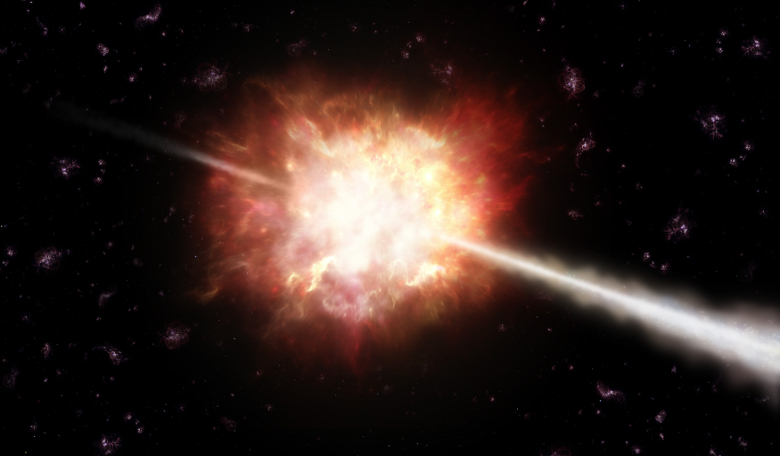It is expected that a proportion of Gravitational Wave (GW) progenitors will emit an ElectroMagnetic (EM) signal in the form of a short Gamma-Ray Burst (sGRB) and it is this transient signal that has been the focus of recent studies, as the detection of such a signal will not only provide means in which to corroborate the distance to the two events, but it will also, amongst other things, help pinpoint the location of the gravitational wave event.
Now, an international team of researchers have submitted a research paper that states that this idea is in fact the other way around and that it is not the GW event that produces the gamma-ray bursts, but rather it is the bursts that precede the gravitational wave event. Not only that, but by identifying a sequence of gamma-ray burst events, the team have found the first evidence of a binary neutron star system merging into a Kerr-Newman black hole.
When the first gravitational wave event detected by LIGO (GW150194) hit the headlines early this year, scientists were quick to search for an associated gamma-ray event and indeed it was not too long before a gamma-ray burst event, named GW150914-GBM, was identified in the same vicinity at around the same time as GW150194. Many were quick to associate the two events together and if GW150914-GBM really did emanate from GW150914 (the event marking the merger of two black holes), then scientists would have been able to considerably constrain the current location on the sky for GW150914, currently resolved to an area of 600 square degrees – a substantial chunk of the sky – to a much smaller region that could be probed with greater detail by other telescopes. However, it has since been questioned by other scientists if the two events are actually linked.
Short gamma-ray bursts (sGRBs) are a class of gamma-ray bursts (GRB) with a duration of 2 seconds and they undergo two different phases; a short prompt phase, followed by a long-lasting high-energy afterglow phase. sGRBs are thought to be associated with the mergers of a black hole and a neutron star (BH-NS) or two neutron stars coalescing to form a black hole (NS-NS), therefore they are expected to be the EM counterparts for gravitational wave events involving at least one neutron star.
The research paper recently submitted by M. Enderli of the Dipartimento di Fisica, Sapienza Universit`a di Roma, Italy, state that sGRBs can be sub-divided into further classes; short gamma-ray flashes (S-GRFs) that have energies of less than 1052 ergs* and signify the coalescence of two neutron stars to form one massive one and genuine short-GRBs. These latter bursts have energies greater than 1052 ergs and are associated with two neutron stars that merge to form a black hole (BH).
The team go one step further by saying that short-GRBs exhibit three different components: a flash of thermal radiation termed Proper-GRB (P-GRB), the prompt emission, originating from the interaction of accelerated baryons with the circumburst medium and the high-energy (GeV) emission, observed after the P-GRB and indicating the formation of a black hole. This analysis forms part of the ‘fireshell’ scenario that was initially introduced by researchers a few years ago to describe a GRB originating in a gravitational collapse leading to the formation of a Kerr-Newman BH.
The Kerr-Newman black hole identified by Enderli and team is linked to a gamma-ray burst first found by the Fermi/GBM instrument in 2009, known as GRB 090510. By constructing theoretical models using the fireshell scenario, coupled with an unprecedented set of data from the optical-UV all the way up to the high energy (GeV) emission, the team use GRB 090510 as a prototype for sGRBs and perform a new time-resolved spectral analysis of the event. The team distinguish between emission expected from a neutron star merger that results in a black hole against that expected when the two neutron stars instead form a massive neutron star (MNS) and how the different GRB energies can be separated from those associated with supernova explosions.
The updated work on the fireshell theory has been instrumental in allowing the team to not only confirm their theoretical redshift measurement with the spectroscopic redshift measurement of GRB 090510, but also by showing that the gamma-ray and the GeV components originate from different physical processes, therefore allowing the team to order the processes at work. One example the team present is that the delayed onset of the GeV emission originates from the matter accretion onto the newly-born black hole and that it is observable only after the P-GRB emission.
Consequently the model has allowed the team to present in their paper the starting point of the high energy emission associated with the birth of a black hole, by confirming that GRB 090510 is a short gamma-ray burst, originating in a binary neutron star merger and not the other away around, as is commonly thought at present.
For more information on this research, see: http://arxiv.org/pdf/1607.02400.pdf
* The erg is a unit of energy and work equal to 10−7 joules. It is the amount of work done by a force of one dyne exerted for a distance of one centimetre. A dyne is the force required to accelerate a mass of one gram at a rate of one centimetre per second squared and is therefore not a standard SI unit but it is used by many astronomers when describing high-energy phenomena such as gamma-ray bursts.











